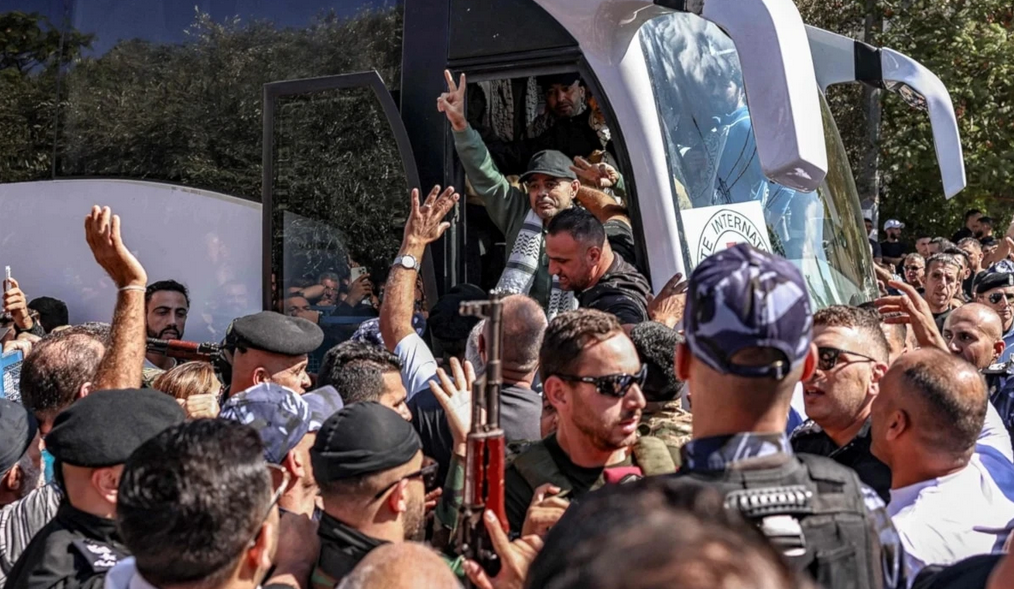
When the first images of Ayham Kamamji surfaced after his release from Israeli prisons, his defiant words in the courtroom during his trial echoed through Palestine:
“We will walk out through the door, above the ground. Just as we conquered you below it; we will conquer you above it.”
Kamamji, one of the six heroes of the “Freedom Tunnel” operation, had long envisioned liberation as an inevitable destiny. He was freed under the latest prisoner exchange deal, though exiled along with his comrade Mahmoud al-Arda, the engineer of the prison break operation.
The resistance had pledged to secure the release of the “Freedom Tunnel” prisoners in any future swap, a promise it fulfilled. Five of the six men are now free: Zakaria al-Zubeidi, Mohammad al-Arda, and Eyad Jaradat were released in the first swap deal, while Mahmoud al-Arda and Ayham Kamamji were released in this round. Still behind bars are Yaqub Qadri, serving a life sentence, and Munadil Nfeiat, sentenced to a long term.
Before the tunnel operation shook Israel’s security establishment, Kamamji’s name was little known outside Jenin. Yet his record tells a story of relentless resistance. In 2003, while still a high school student, he attempted his first operation: a car bombing that failed after the vehicle malfunctioned, turning him into a fugitive.
After spending a year and a half in the Palestinian Authority’s custody, he escaped from Jericho Prison and returned to Jenin, where he carried out shooting operations targeting Israeli settlers and soldiers. In 2006, he and his comrades abducted Israeli settler Eliyahu Asheri from the Itamar settlement near Nablus. The Al-Nasser Salah al-Deen Brigades in Gaza claimed responsibility, demanding an end to Israel’s ground invasion following the capture of Gilad Shalit, and offering a prisoners-for-captive swap.
Israeli forces eventually caught the group in al-Balou, Ramallah, arresting Kamamji and his comrades after a violent siege. Following brutal interrogation, a military tribunal sentenced him to two life terms.
Mahmoud Issa
From Anata, in occupied Jerusalem, Mahmoud Issa founded and commanded the first special operations unit within the Qassam Brigades: Unit 101. In December 1992, his cell abducted Israeli First Sergeant Nissim Toledano near Lod and demanded the release of Sheikh Ahmad Yassin in return. When Israel refused, the soldier was executed, and the unit continued its operations, carrying out attacks that resulted in several Israeli deaths.
Issa and his comrades were hunted for six months before he was captured in June 1993 with his companions Majed Qteish, Mousa al-Akari, and Mahmoud Atoun. Subjected to harsh interrogation at the Moskobiya detention center, Issa was labeled as one of Israel’s “most dangerous detainees” and sentenced to three life terms plus 46 years. His name was added to the exchange list at the last minute.
Mohammad Imran
A leading strategist of the “Death Alley” ambush during the Second Intifada, Mohammad Imran (43) was released and deported to Gaza. As a senior commander in Islamic Jihad’s Al-Quds Brigades in Hebron, Imran helped orchestrate the 2002 operation in Wadi al-Nasara, in which 13 Israeli soldiers, including a senior officer, were killed.
Kamil Abu Hanish
Known among inmates as “the comrade,” Kamil Abu Hanish walked out to freedom after being sent to nine life sentences. A fusion of intellect and resistance, he became one of the most respected writers and theorists of the Palestinian prison movement. A founding commander of the Popular Front’s military wing — later renamed the Abu Ali Mustafa Brigades — Abu Hanish was accused of several operations in Nablus and the northern West Bank, including the 2002 Itamar operation, which killed five settlers and injured ten others. He also took part in the defense against Israeli forces during the 2002 invasion of Nablus.
Ahmad Jamal al-Qanbaa
Palestinians recalled the viral courtroom footage of Ahmad Jamal al-Qanbaa shouting at Shin Bet officers:
“I’ll walk out free. Free! I will walk out!”
A member of the Ahmad Nasser Jarar cell, al-Qanbaa was involved in several operations targeting Israeli forces and settlers, including the 2018 shooting of Rabbi Raziel Shevach, claimed by the Qassam Brigades. In 2023, an Israeli court sentenced him to life plus 26 years and fined him 1.5 million shekels.
Ismail al-Masri
After 23 years behind bars and ten life sentences, Majed Ismail al-Masri of Balata refugee camp in Nablus walked free. Once a member of the Palestinian National Security Forces, he co-founded the Al-Aqsa Martyrs Brigades at the start of the Second Intifada, serving as its spokesperson under the name “Abu Mujahid.” After the arrest of commander Nasser Awais, al-Masri assumed the group’s leadership until his capture.
Ahmed Al-Abed
Source: Al Akhbar